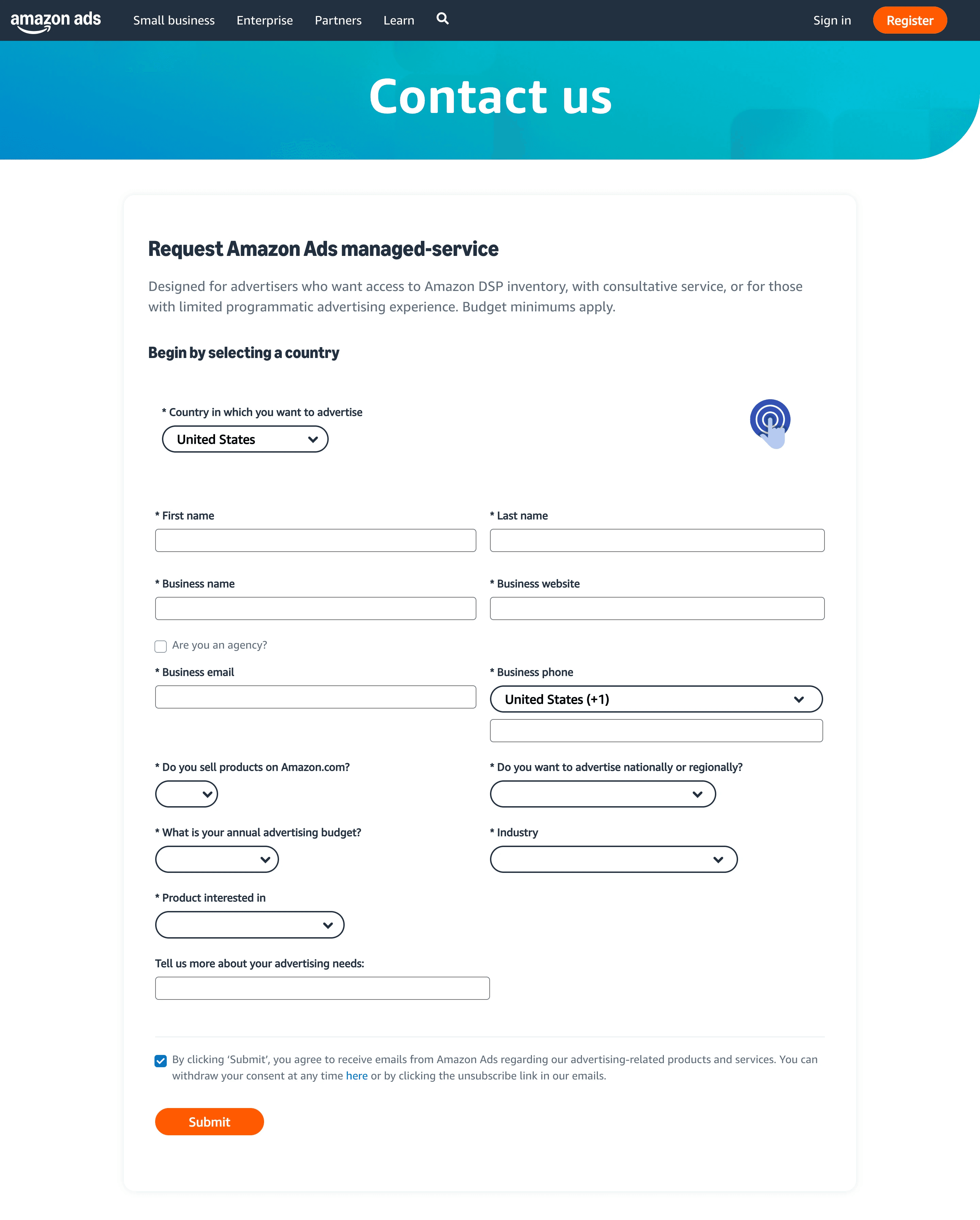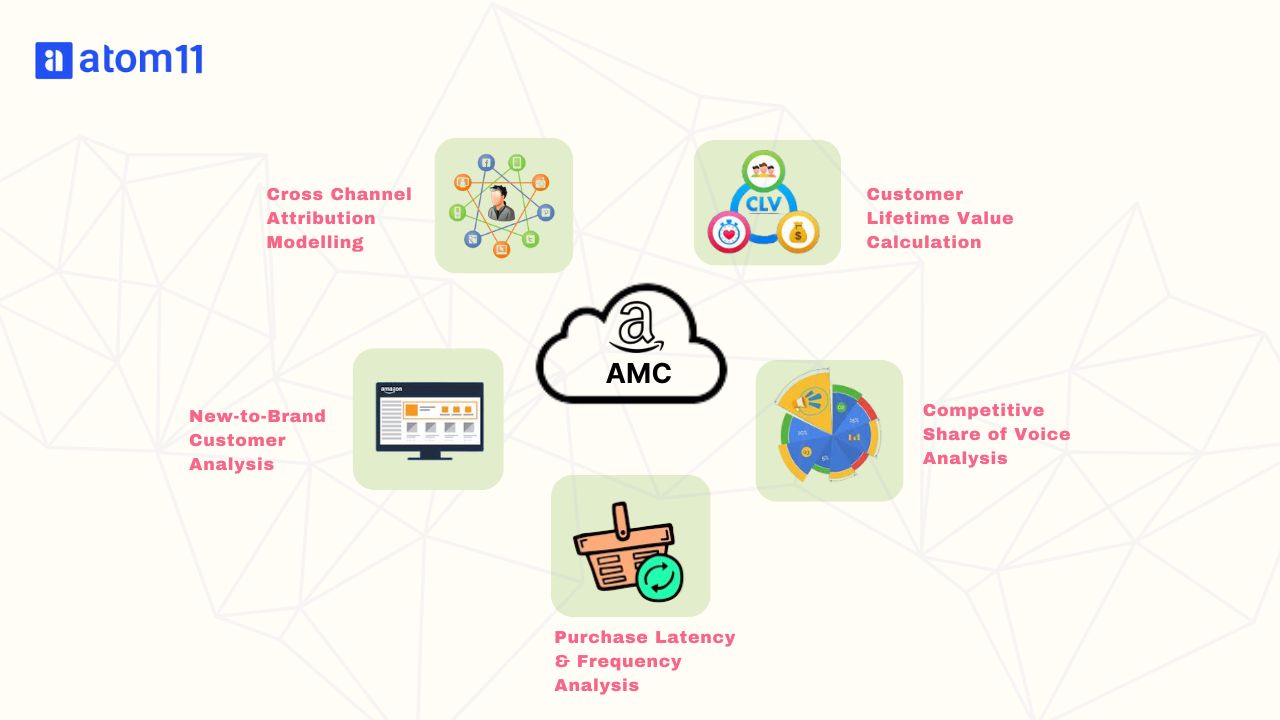Concepts
Guide to Amazon Marketing Cloud: Process & Use Cases
Learn how to get started with Amazon Marketing Cloud, covering its eligibility criteria, essential requirements, and practical use cases to help you enhance your retail or e-commerce brand
Oct 21, 2024
What is the Amazon Marketing Cloud?
Who is eligible to use Amazon Marketing Cloud in 2024?
What are the top 4 essentials to use Amazon Marketing Cloud?
How to Register With Amazon Marketing Cloud?
How does AMC differ from Regular Amazon ads Insights & Reports?
What are the top 5 Use-Cases of Amazon Marketing Cloud with examples?
FAQs
Introduction
Imagine you own an online store that sells organic skincare. You’ve a limited budget from which you’re investing in Amazon ads, running Sponsored Products ads, creating eye-catching Sponsored Brand ads and even engaging video ads.
Despite all this effort, you’re still unsure which ads are truly driving sales and which are draining your budget. You wonder how customers are interacting with your ads. Are they clicking on a Sponsored Product ad and buying immediately? Or are they seeing a video ad, then a display ad, and purchasing days later?
Analysing customer interactions can be challenging especially when traditional reporting tools only provide a limited view. This is where Amazon Marketing Cloud (AMC) comes into play. AMC is a powerful analytics tool that can transform how you analyse and improve your marketing efforts on Amazon.
In this guide, we’ll dive in deep about what Amazon Marketing Cloud is, how it works, and how you can utilise its capabilities to improve your retail or e-commerce brand.
What is Amazon Marketing Cloud?
Before the introduction of advanced analytics tools like Amazon Marketing Cloud (AMC), advertisers on Amazon faced significant challenges in understanding the full impact of their marketing efforts. They had access to basic “aggregated” metrics like clicks, impressions, and conversions for individual ad campaigns.
But they lacked a holistic view of how different ads worked together to influence customer buying behaviour. This made it difficult to identify ads opportunities at customer cohort level (vs. keyword level).
Amazon Marketing Cloud (AMC) is a secure, cloud-based analytics platform by Amazon. Instead of being a set of pre-built, aggregated reports that you get on Amazon Sponsored Ads, AMC is a database.
Let us understand the difference in a detailed way:
Today, Amazon gives you aggregated reports on keyword level. This means that if 1000 customers clicked on your ad, after seeing that keyword, Amazon will aggregate data from all those 1000 customers and show you 1 line item of that keyword’s performance:
AMC is not an aggregate report. It is a detailed database. Amazon will now let you query a database, in which every customer interaction is a line item. Some examples are given below:
Path to purchase: You can use the database to find how many times does your customer interact with different ads before making a product purchase.
Example. Customer X first saw your Sponsored Product ad, then Sponsored Display ad, followed by Sponsored Brand video ad (two times) before buying your product.
Frequency Cap: You can use the database to find how many ad exposures are required, to convince a customer to buy your product. If a customer converts after a frequency of 10, then you need to show more ads to the same customer before they can convert. But if the customer converts at an average frequency of 2, that means you can remove excess ad spend on showing ads to the same customer
Keyword-ASIN relationship: You can use the database to find which keyword helps you sell which ASIN in the most effective way. For example, If you sell 5 types of face cleansers. With AMC data, you can find which keywords lead to sales of which ASINs. You can also find which ASINs are better for new customer acquisition, while which ones are good for repeat purchases.
This database is a clean room, which means while you are able to track the action of each customer, the customer's personal details are hidden. These details will help you make informed, data-driven decisions to optimise your marketing strategies, improve campaign performance, and ultimately achieve better results for your retail or e-commerce brand.
Who is eligible to use Amazon Marketing Cloud in 2024?
The Amazon Marketing Cloud is now more accessible than ever. Originally, only advertisers with Amazon DSP (Demand-Side Platform) accounts could use Amazon Marketing Cloud (AMC). But recently at UnBoxed2024, it was announced that all Amazon advertisers (i.e. advertisers running sponsored ads like Sponsored Products and Sponsored Brands) are now eligible to use AMC.
What Does This Mean?
No DSP Account Needed: You don’t need to have a DSP account anymore. This opens up AMC to a wider range of advertisers, including small and medium-sized businesses.
ALL advertisers have access: Whether you’re advertising with Sponsored Products or Sponsored Brands, you can now access AMC to gain deeper insights into your campaigns.
Example:
Suppose your organic skincare store is running Sponsored Products ads. Before, you couldn’t use AMC without a DSP account. Now, you can access AMC to see how your sponsored ads contribute to sales and how they interact with other marketing efforts.
What are the top 4 essentials to use Amazon Marketing Cloud?
AMC is designed for advertisers who have:
Minimum budget: The minimum annual advertising budget you require to use AMC is $5000/year
Compliance with Data Policies: Ensure adherence to Amazon’s data protection and usage policies, and comply with all relevant privacy regulations in the 17 global marketplaces where AMC is available.
Other good to have requirements:
AWS Account Access: If you want to create your own AMC dashboard, you will . need an Amazon Web Services (AWS) account
Familiarity with SQL: Although you can use Amazon’s pre-built queries to analyse usual use cases, to query an advanced set of data, you will need proficiency in SQL.
How to Register With Amazon Marketing Cloud?
Verify your eligibility with all the above essentials and if you check all the boxes then fill out the form available on Amazon Advertising portal.

How Does AMC Differ from Regular Amazon Ads Insights & Reports?
Amazon Marketing Cloud (AMC) is like a powerful database where you can run custom queries to explore your advertising data and consumer behaviours in depth. In contrast, Amazon Ads Insights and Reports provide standard reports with predefined metrics and summaries like impressions, clicks, and sales for each campaign. These metrics are useful but they don’t show you how different campaigns and channels work together.
Here’s how AMC stands out:
A Complete View: AMC lets you see the entire customer journey by combining data from different campaigns and channels. This helps you understand how various ads work together to drive sales.
Custom Analysis: With AMC, you can ask specific questions by running queries tailored to your needs. This flexibility allows you to dig deeper into your data.
Deeper Insights: AMC provides detailed, anonymized data that you can analyze to uncover patterns and trends that standard reports might miss.
Example
Imagine your organic skincare store wants to know how many times a customer needs to see your ads before they make a purchase. With regular reports, you might see that your Sponsored Products ad generated 100 sales, but you don’t know how many ad impressions it took to achieve that.
Using AMC, you can run a query to find out that most customers made a purchase after seeing your ads three times. This insight helps you optimize your ad frequency to improve sales without overspending.
What are the top 5 Use Cases of Amazon Marketing Cloud with examples?

Cross-Channel Attribution Modelling
Understand how different marketing channels work together to lead customers to purchase your products. This helps you see the full path a customer takes, from the first ad they see to the final sale.
Example: You discover that customers who see your ads on both social media and Amazon are more likely to buy, so you coordinate your campaigns across these channels.
New-to-Brand Customer Analysis
Identify customers who are purchasing from your brand for the first time. This helps you tailor your marketing strategies to attract more new customers.
Example: You find that many new customers respond well to your Sponsored Brands ads, so you focus more on this ad type to grow your customer base.
Purchase Latency and Frequency Analysis
Analyse how long it takes for customers to make a purchase after seeing your ads and how often they buy. This helps you optimise the timing and frequency of your marketing efforts.
Example: You learn that most customers purchase within seven days of seeing your ad, so you adjust your campaigns to retarget customers within that time frame.
Competitive Share of Voice Analysis
Measure how much visibility your brand has compared to competitors. This helps you understand your position in the market and make adjustments to improve your presence.
Example: You notice that your share of voice is lower than a key competitor’s, so you increase your ad spend or optimise keywords to improve visibility.
Customer Lifetime Value Calculation
Determine the total value a customer brings to your business over time. This helps you make informed decisions about how much to invest in acquiring and retaining customers.
Example: You calculate that customers acquired through Sponsored Brands ads tend to spend more over time, so you invest more in that ad type to maximise long-term profits.
Conclusion
Amazon Marketing Cloud is a valuable tool that helps you understand and improve your advertising on Amazon. It gives you clear insights into how your ads work together and how customers interact with them, allowing you to make better marketing decisions.
At Atom11, we help you automate, optimise and scale your Amazon ads to grow your business. To learn more about AMC services at Atom11, Get in touch with us!
FAQs
1. Is Amazon Marketing Cloud only for large advertisers?
No, AMC is now available to advertisers of all sizes, including small and medium-sized businesses, as long as they meet the minimum annual ad spend requirement of $5,000/year. Even smaller businesses can benefit from AMC’s powerful insights to optimise their campaigns.
2. Do I need a DSP account to use Amazon Marketing Cloud?
No, you no longer need a DSP account to access AMC. As of 2024, advertisers running Sponsored Ads like Sponsored Products and Sponsored Brands can access AMC without a DSP account.
3. How does AMC protect customer privacy?
Amazon Marketing Cloud operates as a “clean room,” which means that while you can track customer actions and interactions with your ads, all personal identifiable information (PII) is anonymized. This ensures data privacy while allowing you to analyse customer behaviour.
4. Can AMC help improve my return on ad spend (ROAS)?
Yes, AMC helps you make data-driven decisions that optimise your ad spend. By understanding which ads work best together and identifying the customer’s path to purchase, you can allocate your budget more effectively, leading to a better ROAS.
5. Do I need technical skills to use Amazon Marketing Cloud?
While Amazon provides pre-built queries for common use cases, having a basic knowledge of SQL is recommended if you want to run advanced custom queries to dive deeper into your data.


